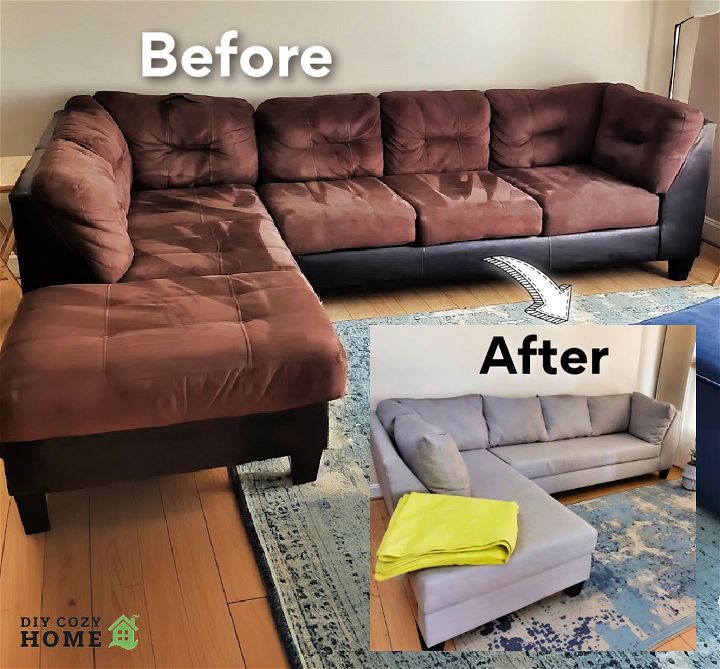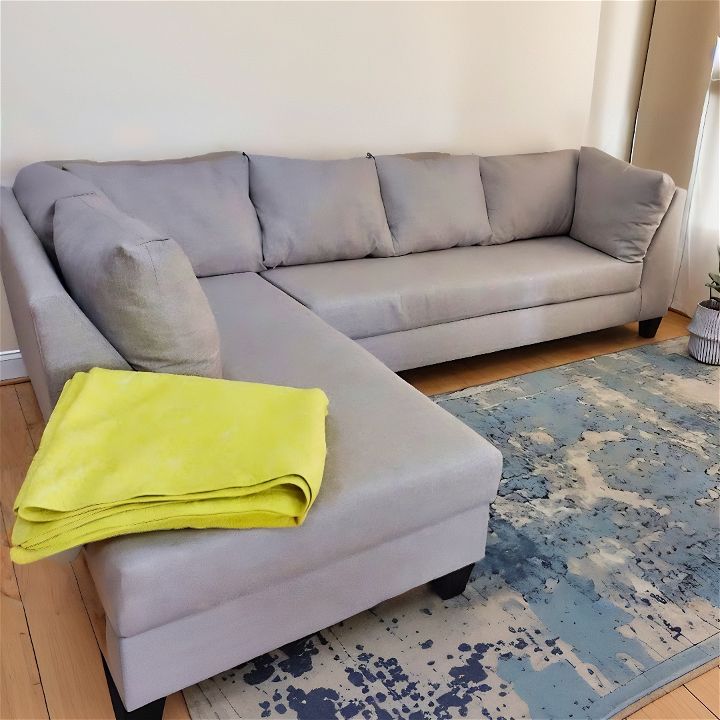Transforming an old, dull couch into a stunning piece of furniture can seem daunting. However, with some patience, creativity, and this step-by-step guide on how to reupholster a couch, you can breathe new life into a boring brown sectional, making it both beautiful and unique. This DIY reupholstery couch project is not just about saving money; it’s about creating a piece that perfectly fits your space and style. Whether you’re an experienced DIY enthusiast or a beginner, these reupholstering couch instructions will guide you through the process of giving your couch a complete makeover.

Restoring vs. Reupholstering: Understanding the Difference
When giving a couch a new life, it’s crucial to know whether you’re restoring or reupholstering it. Restoring means bringing the couch back to its original state, preserving its authenticity and value, especially for vintage pieces. This often involves minor fixes and cosmetic touch-ups. Reupholstering, on the other hand, involves replacing the fabric, and possibly the padding and springs, giving the couch a completely new look. It’s a way to modernize an old piece or to make an outdated piece fit with your current decor.
Prepping Your Couch: Is It Worth Reupholstering?
Before diving into reupholstering your couch, it’s essential to evaluate if it’s worth the effort and cost. Start by assessing the frame’s condition. A sturdy, hardwood frame is a good candidate for reupholstery. Look for signs of wear or damage. If the frame is in good shape, you’re more likely to have a worthwhile project on your hands.
Next, consider the costs. Reupholstering can range significantly based on fabric choice and the couch’s size and design. Do a quick cost analysis by getting quotes for reupholstery and comparing those to the price of a new couch. Remember, reupholstering is not just about getting a new look; it’s also about quality and sustainability.
Safety First: Essential Precautions
Before diving into reupholstering, ensure your safety, especially when working with older furniture. Vintage couches can harbor dust, mold, and sometimes harmful chemicals:
- Wear protective gear: Always wear a mask and gloves to protect yourself from inhaling dust or coming into contact with potentially harmful substances.
- Ventilate the area: Work in a well-ventilated space to avoid inhaling fumes from adhesives, finishes, or old materials.
- Be cautious of springs: Old couches often have metal springs that can be sharp or rusted. Handle with care to avoid injury.
- Check for chemicals: Be aware of the materials you’re working with. Some older furniture may contain lead paint or formaldehyde. Consider having the piece professionally assessed if you’re unsure.
Always prioritize safety, especially when dealing with older furniture, and take your time to ensure a result you’ll be proud of.
Upholstery Styles to Match Your Decor
Learn the perfect upholstery styles to match your decor with a quick dive into history, tips for pairing fabrics, and modern DIY twists.
A Quick Dive into History
Couch styles have evolved significantly over the years, providing a rich source of inspiration for those looking to reupholster their furniture. The sleek, clean lines of Mid-century modern sofas, with their emphasis on function and form, contrast sharply with the luxurious, button-tufted design of the Chesterfield, which exudes elegance and class. Each style reflects the aesthetic and cultural values of its time, offering unique characteristics that can be leveraged to make a statement piece in your home.
Pairing Fabric to Form
The right fabric can dramatically enhance the shape and feel of your couch. For example, a velvet fabric can add depth and warmth to the traditional curves of a Chesterfield sofa, emphasizing its classic beauty. On the other hand, a geometric-patterned wool can complement the simple lines of a Mid-century piece, adding texture and interest without overwhelming its design. When choosing a fabric, consider both the style of the couch and the overall decor of the room to ensure a cohesive look.
Modern DIY Twists
Bringing an old-fashioned couch into a contemporary setting doesn’t have to be complicated. One way to update your piece is by choosing modern colors and patterns that can breathe new life into a vintage frame. Think bold, vibrant hues or minimalist, Scandinavian-inspired prints that can transform your couch into a modern masterpiece. Additionally, consider incorporating contemporary design elements, such as adding sleek, metal legs to a traditional sofa to create an interesting juxtaposition of styles.
By carefully selecting fabrics and considering modern design elements, you can successfully blend the old with the new and create a piece of furniture that is both unique and reflective of your personal style.
Choosing the Right Fabric: Beyond the Look
Selecting the right fabric is crucial for your reupholstered couch. Understand fabric terms to make an informed decision:
- Durability Ratings: Look for the double rub count on fabric specifications. Higher counts are more durable.
- Weaves and Patterns: Tight weaves and patterns can hide wear and tear better than plain, light colors.
Conduct fabric testing to ensure quality. A small ‘burn test’ (safely done and with caution) can help identify synthetic fibers from natural ones. Also, check for pilling (when small balls form on the fabric surface) and snagging potential by lightly scratching the fabric with your nail.
What Will I Get Out of This?
By following this how to reupholster a couch guide, you’ll learn how to:
- Disassemble your couch and prepare it for reupholstering.
- Choose and prepare your materials for a durable and appealing result.
- Sew and attach new fabric to your couch, transforming its appearance.
- Reassemble your couch, complete with new cushions and upholstery.
Materials Needed
- Upholstery Fabric: Choose a durable, easy-to-clean fabric that complements your decor.
- Staple Gun and Staples: A heavy-duty staple gun is essential for attaching fabric securely.
- Upholstery Thread: Heavy-duty thread that can handle the weight and wear of the fabric.
- Sewing Machine: For stitching fabric pieces together.
- Foam Cushions and Batting: If your cushions need replacing or you want to alter their shape.
- Zippers: For removable cushion covers.
- Scissors, Seam Ripper, and Measuring Tape: Basic tools for cutting fabric and measuring.
- Spray Adhesive: For adhering foam pieces together or to the couch frame.
- Screwdriver or Wrench: For disassembling the couch.
- Non-Slip Fabric: For the bottom of the couch to prevent sliding.
Step-By-Step Instructions to Reupholstering a Couch
Learn how to reupholster a couch in easy steps! Our guide provides step-by-step instructions. Get started now!

1. Disassemble and Clean Your Couch
- Remove all cushions and disassemble any parts of the couch that are easy to take apart, like legs or removable panels.
- Clean the couch thoroughly, vacuuming away all dust and debris.
2. Measure and Cut Your Fabric
- Measure each part of your couch and cut your new fabric accordingly, allowing extra for seam allowances and stretching over the frame.
3. Prepare Your Cushions
- If you’re replacing foam, cut your foam to size now.
- For a modern touch, consider combining smaller cushions into one large cushion using spray adhesive and adding new batting for a smooth finish.
4. Sewing Your Fabric
- Using your sewing machine and upholstery thread, start sewing the fabric pieces together. Remember to do any necessary tufting or add zippers for removable covers as you go.
5. Attaching the Fabric to the Couch
- Start with the larger areas first, using your staple gun to attach the fabric. Stretch it tightly to avoid wrinkles and secure it well.
6. Reassemble Your Couch
- Once all fabric is attached, put any disassembled parts back together.
- Place your newly covered cushions back onto the couch.
Common Pitfalls and Troubleshooting
- Fabric stretching unevenly: Ensure you’re pulling the fabric tight and evenly as you staple.
- Mismatched patterns: Pay extra attention when cutting patterned fabric to ensure it aligns.
- Staple gun issues: Invest in a quality staple gun to avoid frustration and ensure staples are flush with the wood.

Video Tutorial
Want a visual demonstration? Watch a step-by-step video tutorial on YouTube for a clear and easy-to-understand walkthrough of How to Reupholster a Couch with Techniques. It’s a great companion to this written guide.
Tackling the Unexpected: Problem-Solving During Your Project
When reupholstering, you might face a few challenges:
- Crooked Staples: If staples get crooked, gently remove them with a staple remover and reapply correctly to ensure a tight and even fit.
- Short Fabric: If your fabric seems too short, check if you can reposition it or sew a matching piece to extend it. Always measure twice and cut once to avoid this issue.
- Professional Help: If you encounter significant issues or feel overwhelmed, it might be time to consult a professional. Their expertise can save you time and ensure a polished result.
Beyond the Basics: Adding Custom Touches
To truly personalize your couch, consider adding custom touches:
- Simple Piping Techniques: Piping can add a refined look to your couch. You can make your own piping with fabric matching or contrasting your couch.
- New Cushion Shapes: Experiment with bolsters or other shapes for a unique style.
- Decorative Buttons or Tufting: These details can add elegance and interest. There are numerous tutorials online that guide you through the process, from choosing the right buttons to executing tufting patterns.
Reupholstery on a Budget: Smart Ways to Save
Reupholstering your couch can give it a fresh new look and extend its life without breaking the bank. Here’s how you can save money on your next reupholstery project.
Fabric Alternatives
You don’t have to spend a fortune at upholstery stores to find quality fabric for your couch. Consider repurposing materials such as curtains, tablecloths, or even durable drop cloths. These fabrics can offer unique patterns and textures at a fraction of the cost. When choosing fabric, ensure it’s durable enough to withstand regular use, especially if your couch gets a lot of traffic.
Cushion Strategies
Before you buy new fillings for your cushions, assess the current ones. Often, existing fillings can be reused, saving you money. If they’re in good shape but a bit flat, consider adding more filling to plump them up rather than replacing them entirely. If you do need new fillings, look for less expensive alternatives. High-density foam is a popular choice, offering comfort and durability without a hefty price tag. Comparing prices and materials at different suppliers can lead to significant savings.
The DIY vs. Pro Balance
Deciding between DIY and hiring a professional depends on your skills, the project’s complexity, and your budget. Simple tasks like removing old fabric and stapling new fabric can easily be done yourself with basic tools and some patience. There are plenty of tutorials online that can guide you through the process.
However, if your couch requires structural repairs or complex fabric patterns that need to be matched, hiring a skilled professional might be worth the investment. Professionals can ensure a high-quality finish that lasts, potentially saving you money in the long run by avoiding costly mistakes.
By being smart about fabric choices, cushion strategies, and balancing DIY with professional help, you can reupholster your couch beautifully without spending a fortune.
Conclusion
Reupholstering a couch is a rewarding project that can save an old piece of furniture from the landfill and give it a personal touch. It might take time and patience, but the end result is a beautiful, custom piece that reflects your style and adds warmth to your home. Remember, DIY reupholstery couch is a creative process, so take your time, experiment, and most importantly, enjoy transforming your couch into something beautiful!
FAQs: Answers to Your Top Reupholstery Questions
Reupholstering can give your old sofa a brand-new look and also help you save money, but it’s understandable to have questions before starting. Here are some of the most common ones, with clear and helpful answers:
1. Is reupholstering really cheaper than buying new furniture?
Not always. Whether reupholstering is cheaper depends on a few factors. It’s worth the investment if your couch has a well-made, sturdy frame. The cost of designer fabrics, complex upholstery techniques, and professional labor can all add up. Doing it yourself saves the most money, but it also takes significant time.
2. How can I estimate the cost of reupholstering my couch?
The best way is to contact several upholsterers in your area and get quotes. Let them know the type of couch, size, and your desired fabrics. You’ll also need to figure out how much fabric you’ll need; online calculators can help you estimate that based on the couch’s measurements. Remember, if you go the DIY route, you’ll save on labor costs but compare that to the value of your own time.
3. Can I reupholster my couch myself?
Definitely! If you have a simple couch style (avoid complicated curves or tufting for your first project), are willing to learn from online resources, and have the time to dedicate to the project, DIY reupholstery is achievable.
4. How long does reupholstered furniture last?
A reupholstered couch can easily last another 10-20 years if you use good quality materials and do it well (or hire a skilled upholsterer). A solid wood frame is key for longevity, and regular cleaning and protecting the fabric from harsh sunlight will also help it last.
5. Can I use any type of fabric for reupholstery?
While you technically can use almost any fabric, it’s best to choose upholstery-grade fabrics. These are specifically designed to withstand wear and tear. Look for rub tests or durability ratings when choosing. Also, avoid fabrics that are too thin or have a loose weave, as they will snag more easily.
6. What if my couch is damaged underneath the fabric?
You may be able to fix minor damage yourself. Loose springs can often be re-tightened or tied, and small cracks in the wood can be fixed with wood glue and clamps. If there’s major damage to the frame, it’s best to get a quote from a professional before you start your project.
7. Should I keep the original cushions or replace them?
It depends on their condition. If they’re flattened, saggy, stained, or have an odor, it’s usually best to replace them. However, if they’re still firm and supportive, you can simply clean them thoroughly and reuse them to save some money.
8. How do I find the right upholsterer if I’m not doing it myself?
Finding a skilled and reliable upholsterer takes a bit of research. Get recommendations from friends or local furniture stores. Check online reviews and websites, looking at the upholsterer’s portfolio of work. Always get multiple detailed quotes, and ask about their experience with styles similar to your couch.
9. Can I change the style of my couch during reupholstery?
To some extent, yes! Reupholstering gives you the freedom to change the overall look of your couch. Consider adding or removing tufting for a dramatic change. Using piping can define the couch’s shape differently. Of course, the biggest transformation comes from your choice of fabric – bold colors, patterns, or textures can completely update the style.
10. Are there any eco-friendly reupholstery options?
Yes! Reupholstery is inherently more sustainable than buying new furniture. You can make it even more eco-conscious by choosing natural, sustainably sourced fabrics like organic cotton or linen. Look for recycled or upcycled materials. You can even repurpose unexpected fabrics like vintage tablecloths or strong canvas drop cloths. Get creative!
Before and After Reupholstering a Couch
Transform your old couch into a stunning piece of furniture – Pin it to Pinterest and share the love!

About the Author:
Jane Smith has been a professional upholsterer for over 5 years, specializing in furniture restoration and repair. She is passionate about helping people breathe new life into their furniture and has written numerous articles sharing her expertise on the subject. Jane’s step-by-step guide to reupholstering a couch is a must-follow for anyone looking to tackle a DIY furniture project.




